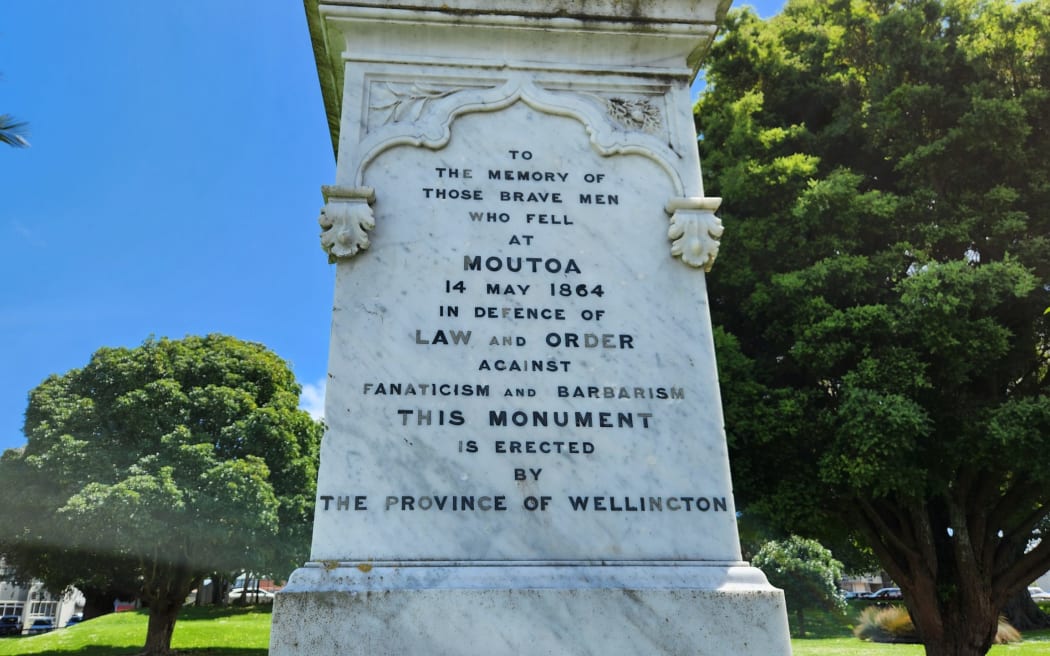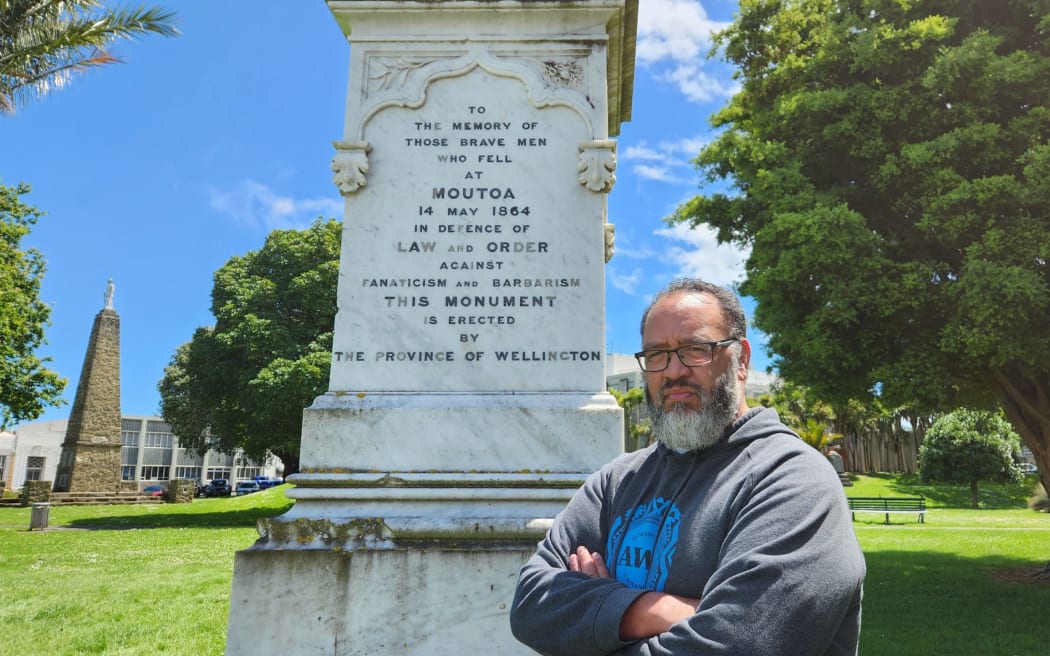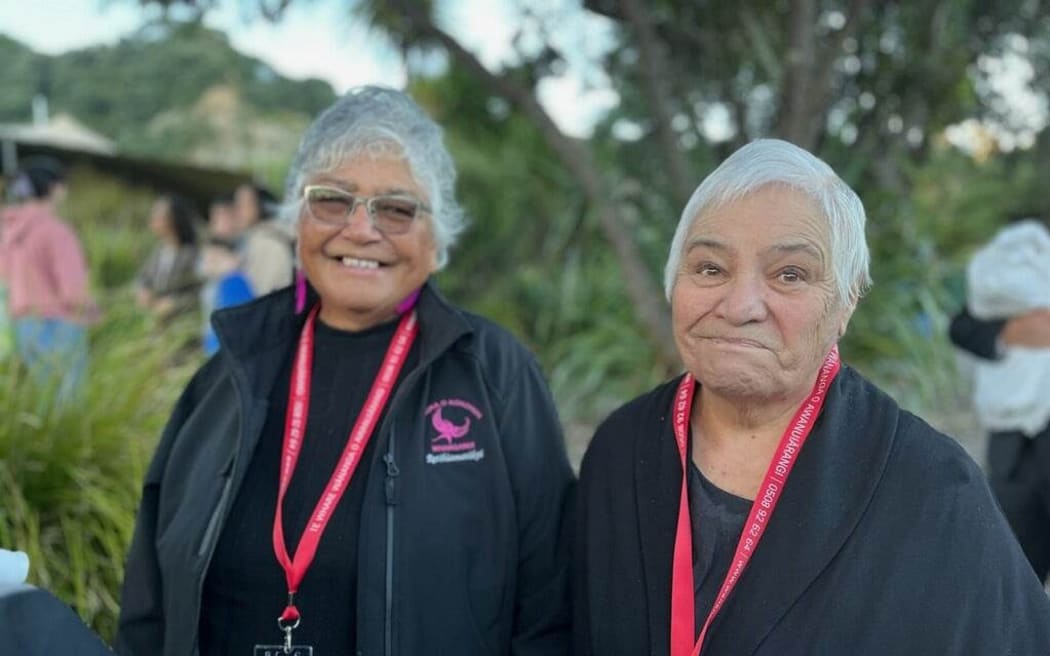
The offending inscription on New Zealand's oldest war memorial. Photo: LDR / Moana Ellis
The country's oldest war memorial will be removed from an historic Whanganui reserve following objections to an inscription condemning upriver Māori for "fanaticism and barbarism".
Whanganui River iwi representatives say the language on the 158-year-old Weeping Woman monument is offensive and a blight on the history of Whanganui.
Representatives also say the white marble statue supports "on-going racist stereotyping" and could cause intergenerational harm to tamariki and mokopuna of Whanganui River iwi.
The monument was erected in 1865 on the banks of the Whanganui River at Pākaitore, an historic trading site, seasonal village and gathering place for Māori.
It commemorates 15 Māori and one European killed in an 1864 battle with upriver Māori at Moutoa island, 80km from Whanganui.
Europeans saw the incident as proof of loyalty by "friendly natives at Wanganui" defending the fledgling settlement against a taua (war party) from the upper reaches.
Heading downriver, and intent on driving the settlers away, the taua was forced to retreat after fierce fighting, leaving behind at least 50 slain warriors, according to some accounts.
Six weeks later, the Wellington Provincial Council resolved to erect a monument in recognition of "patriotic services".

In Sydney, Provincial Superintendent Dr Isaac Earl Featherstone purchased a generic sculpture of a weeping woman and installed it facing the river at Pākaitore on 26 December 1865.
The controversial inscription reads: "To the memory of those brave men who fell at Moutoa 14 May 1864 in defence of law and order against fanaticism and barbarism".
Pākaitore Historic Reserve Board chairperson Jay Rerekura said the Reserve Board decided to remove the monument after a request by Whanganui iwi members.
"For many of us, it's quite an offensive piece of writing, especially because it's sitting down here at Pākaitore, a place that's special to us," Rerekura told Local Democracy Reporting.
"That inscription is in our face every time [we] come down to Pākaitore, a place that's very important for uri all the way from the mountain to the sea.
"The kōrero was around whether or not it's something that we want to have out here for our mokopuna and other uri to see - potentially forever."

Chairman Jay Rerekura says the Pākaitore Historic Reserve Board has decided to relocate the Weeping Woman monument to 15 Māori and one European killed in the 1864 Battle of Moutoa. Photo: LDR / Moana Ellis
The petition to the Reserve Board was made by Dame Tariana Turia, kuia Retihiamatikei Cribb and Nancy Tuaine, the kaihautū/CEO of Ngā Tāngata Tiaki o Whanganui.
It followed discussions at Whanganui marae and during this year's annual 28 February commemoration of the 1995 occupation of Pākaitore, when Whanganui Māori occupied the council-controlled park for 79 days.
"The kōrero to remove the statue has been around for some time," Tuaine said. "Even back in the day during the occupation it was part of the conversation.
"I was showing someone around recently and I took them to Pākaitore. They read the inscription and were shocked.
"I thought, why are we allowing this to still be a representation of us as a community?"
The issue was "workshopped" on Pākaitore Day in February and then put before the Whanganui kaumātua kaunihera (council of elders).
Tuaine said some uri (descendants) called for the statue to remain as an aid to conversations about history but there was stronger support to have it moved elsewhere.
The iwi agreed the Weeping Woman should be relocated rather than destroyed, but said education and context should be provided.
"We just asked for it to be removed from Pākaitore," Tuaine said.
"It does recognise whānau who fell as a result of that battle. The majority of them were whanaunga of the upper and lower reaches of our awa.
"What the monument is lacking is context. It describes a period of time where we still had people practising different faiths and beliefs across the length and breadth of the river.
"This statue reflects one part of that story but doesn't talk about the other part.
"To say that the way we practised our values, traditions and beliefs was barbarism or fanaticism is just not okay and is just a symbol of colonisation."

Kuia Retihiamatikei Cribb (left) and Dame Tariana Turia. Photo: Supplied
Tuaine said the Taupo Quay waharoa (entrance) for pōwhiri and ceremony was also partly blocked by the Weeping Woman.
Rerekura said the Reserve Board deliberated at length over the iwi request.
"Ultimately, with combined representation from Whanganui District Council, iwi and the Crown, we were able to come to the decision."
The Reserve Board was established by the Minister of Conservation in 2002 to jointly manage the site.
It followed an agreement signed a year earlier by the Crown, the Whanganui District Council and tangata whenua aimed at ending persistent iwi protests at Pākaitore, which had been renamed Moutoa Gardens by settlers in 1899.
The agreement transferred control of the land from the council to a board made up of one Crown, three iwi and three district council representatives.
No decision has been made on where to relocate the monument.
* Disclosure: Nancy Tuaine is a board member of Awa FM. She took no part in commissioning or editing this story.
Local Democracy Reporting is Public Interest Journalism funded through NZ On Air

